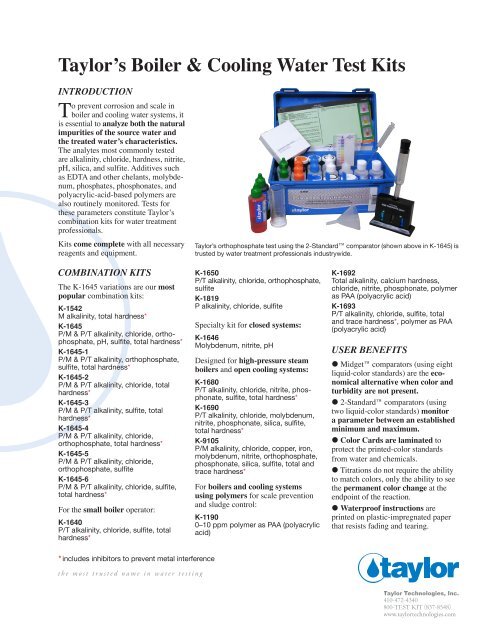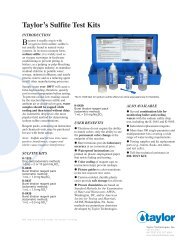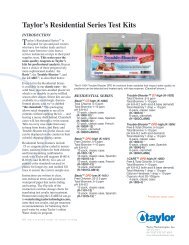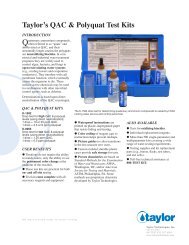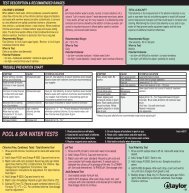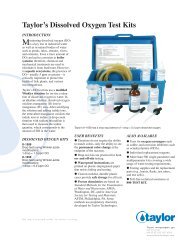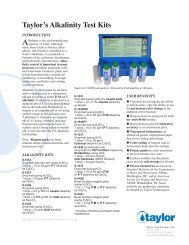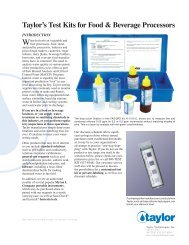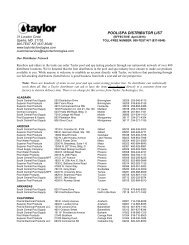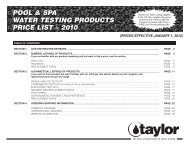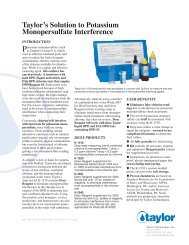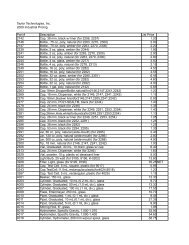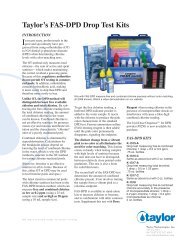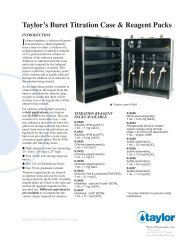Taylor's Boiler & Cooling Water Test Kits - Taylor Technologies
Taylor's Boiler & Cooling Water Test Kits - Taylor Technologies
Taylor's Boiler & Cooling Water Test Kits - Taylor Technologies
You also want an ePaper? Increase the reach of your titles
YUMPU automatically turns print PDFs into web optimized ePapers that Google loves.
<strong>Taylor</strong>’s <strong>Boiler</strong> & <strong>Cooling</strong> <strong>Water</strong> <strong>Test</strong> <strong>Kits</strong><br />
INTRODUCTION<br />
To prevent corrosion and scale in<br />
boiler and cooling water systems, it<br />
is essential to analyze both the natural<br />
impurities of the source water and<br />
the treated water’s characteristics.<br />
The analytes most commonly tested<br />
are alkalinity, chloride, hardness, nitrite,<br />
pH, silica, and sulfite. Additives such<br />
as EDTA and other chelants, molybdenum,<br />
phosphates, phosphonates, and<br />
polyacrylic-acid-based polymers are<br />
also routinely monitored. <strong>Test</strong>s for<br />
these parameters constitute <strong>Taylor</strong>’s<br />
combination kits for water treatment<br />
professionals.<br />
<strong>Kits</strong> come complete with all necessary<br />
reagents and equipment.<br />
<strong>Taylor</strong>’s orthophosphate test using the 2-Standard comparator (shown above in K-1645) is<br />
trusted by water treatment professionals industrywide.<br />
COMBINATION KITS<br />
The K-1645 variations are our most<br />
popular combination kits:<br />
K-1542<br />
M alkalinity, total hardness*<br />
K-1645<br />
P/M & P/T alkalinity, chloride, orthophosphate,<br />
pH, sulfite, total hardness*<br />
K-1645-1<br />
P/M & P/T alkalinity, orthophosphate,<br />
sulfite, total hardness*<br />
K-1645-2<br />
P/M & P/T alkalinity, chloride, total<br />
hardness*<br />
K-1645-3<br />
P/M & P/T alkalinity, sulfite, total<br />
hardness*<br />
K-1645-4<br />
P/M & P/T alkalinity, chloride,<br />
orthophosphate, total hardness*<br />
K-1645-5<br />
P/M & P/T alkalinity, chloride,<br />
orthophosphate, sulfite<br />
K-1645-6<br />
P/M & P/T alkalinity, chloride, sulfite,<br />
total hardness*<br />
For the small boiler operator:<br />
K-1640<br />
P/T alkalinity, chloride, sulfite, total<br />
hardness*<br />
K-1650<br />
P/T alkalinity, chloride, orthophosphate,<br />
sulfite<br />
K-1819<br />
P alkalinity, chloride, sulfite<br />
Specialty kit for closed systems:<br />
K-1646<br />
Molybdenum, nitrite, pH<br />
Designed for high-pressure steam<br />
boilers and open cooling systems:<br />
K-1680<br />
P/T alkalinity, chloride, nitrite, phosphonate,<br />
sulfite, total hardness*<br />
K-1690<br />
P/T alkalinity, chloride, molybdenum,<br />
nitrite, phosphonate, silica, sulfite,<br />
total hardness*<br />
K-9105<br />
P/M alkalinity, chloride, copper, iron,<br />
molybdenum, nitrite, orthophosphate,<br />
phosphonate, silica, sulfite, total and<br />
trace hardness*<br />
For boilers and cooling systems<br />
using polymers for scale prevention<br />
and sludge control:<br />
K-1190<br />
0–10 ppm polymer as PAA (polyacrylic<br />
acid)<br />
K-1692<br />
Total alkalinity, calcium hardness,<br />
chloride, nitrite, phosphonate, polymer<br />
as PAA (polyacrylic acid)<br />
K-1693<br />
P/T alkalinity, chloride, sulfite, total<br />
and trace hardness*, polymer as PAA<br />
(polyacrylic acid)<br />
USER BENEFITS<br />
• Midget comparators (using eight<br />
liquid-color standards) are the economical<br />
alternative when color and<br />
turbidity are not present.<br />
• 2-Standard comparators (using<br />
two liquid-color standards) monitor<br />
a parameter between an established<br />
minimum and maximum.<br />
•<br />
Color Cards are laminated to<br />
protect the printed-color standards<br />
from water and chemicals.<br />
•<br />
Titrations do not require the ability<br />
to match colors, only the ability to see<br />
the permanent color change at the<br />
•<br />
endpoint of the reaction.<br />
<strong>Water</strong>proof instructions are<br />
printed on plastic-impregnated paper<br />
that resists fading and tearing.<br />
*includes inhibitors to prevent metal interference
USER BENEFITS (cont’d)<br />
•<br />
Color coding of reagent caps to<br />
•<br />
instructions helps prevent mishaps.<br />
Picture guides to color transitions<br />
•<br />
in the test reassure new users.<br />
Custom-molded, durable plastic<br />
•<br />
cases provide safe storage for all tests.<br />
Proven chemistries are based on<br />
Standard Methods for the Examination<br />
of <strong>Water</strong> and Wastewater, APHA,<br />
Washington, DC, and/or American<br />
Society for <strong>Test</strong>ing and Materials,<br />
ASTM, Philadelphia, PA. Some<br />
methods use proprietary chemistry<br />
developed by <strong>Taylor</strong> <strong>Technologies</strong>.<br />
ALSO AVAILABLE<br />
•<br />
Myron L Company portable instruments<br />
that may be purchased alone or<br />
•<br />
paired with our reagents.<br />
Microbial tests from Easicult ® and<br />
Sani-Check<br />
• ® .<br />
Syringe filtration system (#9803)<br />
which employs specially-sized filter<br />
discs to remove colloidal color or<br />
turbidity.<br />
• SampleSizer® for 10/25 mL test<br />
volumes (#6190) and SpeedStir ®<br />
magnetic stirrer (#9265) save time for<br />
•<br />
frequent testers.<br />
Demineralizer bottle (8 oz.)<br />
containing an ion-exchange resin that<br />
changes color when it needs replenishing<br />
(R-0804-DD).<br />
•<br />
A wide array of single- and multiparameter<br />
kits featuring color-matching<br />
and/or drop-count tests.<br />
•<br />
<strong>Taylor</strong>’s TTi ® Colorimeter (M-3000);<br />
test 30+ parameters commonly encountered<br />
in commercial and industrial<br />
settings and transfer results to a PC<br />
database.<br />
•<br />
<strong>Test</strong>ing supplies and kit replacement<br />
parts (e.g., burets, flasks, test tubes,<br />
•<br />
and test cells).<br />
Video demonstrations for new<br />
•<br />
users posted on our website.<br />
Toll-free technical assistance at<br />
800-TEST KIT.<br />
REPRESENTATIVE TEST PROCEDURE<br />
Reproduced from K-1645 instruction:<br />
COMPONENTS:<br />
1 x 5067G Instruction<br />
1 x 9198G Sample Tube, Graduated, 25 mL, plastic w/cap and green dot<br />
1 x R-0637-C Methyl Orange Indicator, 2 oz, DB<br />
1 x R-0638G-A Phenolphthalein Indicator (green cap), .75 oz, DB<br />
1 x R-0645-C Total Alkalinity Indicator, 2 oz, DB<br />
1 x R-0687G-C Sulfuric Acid .12N (green cap), 2 oz, DB<br />
TO ORDER REPLACEMENT PARTS AND REAGENTS CALL TOLL-FREE<br />
800-TEST KIT (800-837-8548).<br />
PROCEDURE:<br />
CAREFULLY READ AND FOLLOW PRECAUTIONS ON REAGENT LABELS.<br />
KEEP REAGENTS AWAY FROM CHILDREN.<br />
Alkalinity-P/M (Drop <strong>Test</strong>)<br />
1. Rinse and fill 25 mL sample tube (#9198G) to 25 mL mark with water to be<br />
tested.<br />
2. Add 3 drops R-0638G Phenolphthalein Indicator. Swirl to mix. Sample will turn<br />
pink (Fig. 1) if P alkalinity is present—proceed to Step 3. If no pink color, go to<br />
Step 4.<br />
3. If pink, add R-0687G Sulfuric Acid .12N dropwise, swirling and counting after<br />
each drop, until color changes from pink to colorless. Record drops as P reading.<br />
Always hold bottle in vertical position.<br />
4. Add 5 drops R-0637 Methyl Orange Indicator. Swirl to mix. Sample should turn<br />
yellow (Fig. 2).<br />
5. Continue adding R-0687G Sulfuric Acid .12N dropwise, swirling and counting<br />
after each drop, until color just changes from yellow to orange (salmon pink)<br />
(Fig. 3). Record total drops (Steps 3 and 5) as M reading. Always hold bottle in<br />
vertical position.<br />
DROP TEST<br />
ALKALINITY-PM/PT<br />
6. Multiply P reading by 10. Record as parts per million (ppm) P alkalinity as calcium<br />
carbonate. Multiply M reading by 10. Record as ppm M alkalinity as calcium<br />
carbonate.<br />
(OVER)<br />
Instr. #5067G<br />
Fig. 1<br />
Fig. 2<br />
Fig. 3<br />
DROP TEST<br />
ALKALINITY-PM/PT<br />
Alkalinity-P/T (Drop <strong>Test</strong>)<br />
1. Rinse and fill 25 mL sample tube (#9198G) to 25 mL mark with water to be<br />
tested.<br />
2. Add 3 drops R-0638G Phenolphthalein Indicator. Swirl to mix. Sample will turn<br />
pink (Fig. 4) if P alkalinity is present—proceed to Step 3. If no pink color, go to<br />
Step 4.<br />
3. If pink, add R-0687G Sulfuric Acid .12N dropwise, swirling and counting after<br />
each drop, until color just changes from pink to colorless. Record drops as P<br />
reading. Always hold bottle in vertical position.<br />
4. Add 5 drops R-0645 Total Alkalinity Indicator. Swirl to mix. Sample should turn<br />
green (Fig. 5).<br />
5. Continue adding R-0687G Sulfuric Acid .12N dropwise, swirling and counting<br />
after each drop, until color changes from green to red (Fig. 6). Record total drops<br />
(Steps 3 and 5) as T reading. Always hold bottle in vertical position.<br />
6. Multiply P reading by 10. Record as parts per million (ppm) P alkalinity as<br />
calcium carbonate. Multiply T reading by 10. Record as ppm T alkalinity as<br />
calcium carbonate.<br />
Fig. 4<br />
Instr. #5067G<br />
Fig. 5<br />
31 Loveton Circle, Sparks, MD 21152 U.S.A.<br />
800-TEST KIT (837-8548) • 410-472-4340 4/09<br />
Fig. 6<br />
rev. 100614


